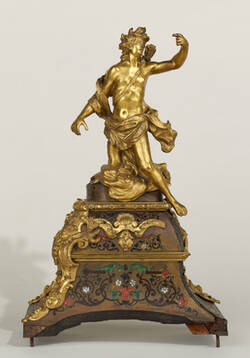Further Media
Until the Second World War, the pedestal and the top of the clockcase formed a set of so-called Apollo pendulum clocks on pedestals with rosette fittings, which was displayed in the so called Kleine Ballsaal in the Residenzschloss. Originally, there were four sets of this clock model. Two were covered by a marquetry with a tortoiseshell base (so called Boulle marquetry in première partie, plus track 6207) and with a ground made of brass (contre partie) and coloured inlays. The quartet was purchased in 1768 from the estate of Count Brühl. The coloured pair was separated in 1925 when, in the course of the settlement with the former Saxon royal family after its abdication following the First World War, works of art were also submitted. The pieces exhibited here belong to the ensemble that remained with the Free State of Saxony.
The marquetry of the pedestal displays a subtle play of colours. As with the coloured Chronos pendulum clock in the first anteroom, the shimmering white mother-of-pearl inlays are accompanied by milky white flowers cut from the mineral selenite. This material has not previously been documented in coloured Boulle marquetry.
Object information
Jean-Pierre Latz
Paris, about 1739
Construction: oak, softwood (pedestal)
Marquetry: tortoiseshell, brass, ebony, ebonised hardwood, horn (coloured backing), mother-of-pearl, selenite
mounts: brass, fire-gilded
Pedestal dimensions: H: 175.5 x W: 73 x D: 9 cm
